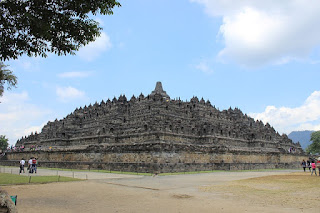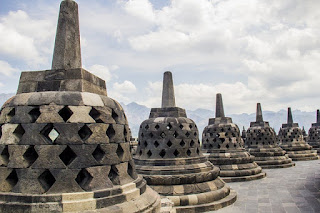Borobudur Tourism and Travel
In Indonesian, ancient religious buildings called temples; term candi is also used more broadly to refer to all the ancient buildings dating from the Hindu-Buddhist in the archipelago, such as gates, gate, and petirtaan (tub and shower bath). The origin of the name Borobudur is not clear, although it is the original name of most temples in Indonesia is not known. The name Borobudur was first written in the book "The History of Java" by Sir Thomas Raffles. Raffles wrote about a monument called borobudur, but there are no older documents that mention the exact same name. The only ancient Javanese manuscripts that give hints on their sacred Buddhist buildings which may refer to Borobudur is Nagarakretagama, written by MPU Prapanca in 1365.
 |
| Another explanation is that the name comes from the two words "coal" and "beduhur". |
Many theories attempt to explain the name of this temple. One of them states that the name is probably derived from the word Sambharabhudhara, which means "mountain" (bhudara) where the slopes are located terraces. In addition there are several other folk etymology. Suppose borobudur word comes from the word "the Buddha" is due to shift borobudur sound. Another explanation is that the name comes from the two words "coal" and "beduhur". The word bara said to have originated from the monastery, while there are also other explanations where the coal comes from the Sanskrit which means temple or monastery complex and beduhur meaning is "high", or to remind the Balinese language means "above". So the point is a monastery dormitories were on high ground.
 |
| Construction of Buddhist temples, including Borobudur when it was possible because Sanjaya heir, Panangkaran grant permission to Buddhists to build temples |
Historian J.G. de Casparis in his dissertation for a doctorate in 1950 argued that Borobudur is a place of worship. Based on the inscriptions Karangtengah and Tri Tepusan, Casparis estimate founder of Borobudur is the king of the Mataram dynasty dynasty named Samaratungga, doing construction around 824 AD The huge building will be completed at the time of her daughter, Queen Pramudawardhani. Borobudur construction is expected to take half a century. In Karangtengah inscription also mentioned about the bestowal of land sima (tax-free land) by CRI Kahulunan (Pramudawardhani) to maintain kamulan called Bhūmisambhāra. The term 'kamulan' itself comes from the word meaning first place origin, the sacred building to honor ancestors, most likely ancestor of the dynasty Sailendra. Casparis estimates that Bhumi Sambhāra Bhudhāra in Sanskrit which means "Hill set of ten levels boddhisattwa virtue", is the original name of Borobudur.
History of creation time
Was not found written evidence that explains who build Borobudur and what it does. Construction time is estimated based on a comparison between the type of script that is written in the legs closed Karmawibhangga with the kind of characters are commonly used in royal inscriptions 8th century and 9th. It is estimated that Borobudur was built around 800 AD. This period of time corresponding to the period between 760 and 830 AD, past the heyday of the house of dynasty in Central Java, who was then influenced Srivijaya Empire. Borobudur Development estimated to spend 75-100 years and actually completed during the reign of Samaratungga in the year 825.
There is confusion as to whether the facts of Javanese kings at that time were Hindu or Buddhist. Sailendra known as Mahayana Buddhist devout, but through inscriptions Sojomerto findings suggest that they may originally Hindu Shiva. In the period that was built many Hindu and Buddhist temples in the Kedu Plain. Based Canggal inscription, in 732 AD, the king of religion Shiva Sanjaya ordered the construction of sacred buildings Shiwalingga built in the hills of Mount Wukir, located only 10 km (6.2 miles) east of Borobudur. Borobudur Buddhist temple built in the same time period with the temples at Prambanan Plain, nevertheless Borobudur is expected to be completed around 825 AD, twenty-five years earlier before the commencement of construction of the Shiva temple Prambanan around the year 850 AD
Construction of Buddhist temples, including Borobudur when it was possible because Sanjaya heir, Panangkaran grant permission to Buddhists to build temples. Even to show his respect, Panangkaran confers Kalasan village to the sangha (Buddhist community), for maintenance and financing Kalasan was built to glorify Bodhisattwadewi Tara (read here Kalasan Temple), as mentioned in kalasan inscription from the year 778 AD. These instructions are understood by archaeologists, that the ancient Javanese society, religion was never an issue that can reap the conflict, exemplified Hindu king could support and fund the construction of a Buddhist temple, and vice versa. However allegedly contained dynastic rivalry between the two kingdoms at that time the Sailendra dynasty who embraced Buddhism and Sanjaya dynasty that worships Shiva then Sanjaya dynasty won the battle in the year 856 in the hills Ratu Boko. Confusion has also been raised regarding the temple Lara Jonggrang in Prambanan, the magnificent temple that is believed to be built by the victor Rakai Pikatan as an answer dynasty Sanjaya to rival the grandeur of Borobudur belong to the house of dynasty, but many people believe that there is an atmosphere of tolerance and togetherness that peace between the two dynastic this ie the Sailendra also involved in the construction of Shiva temple at Prambanan (read here Buddhist temple at Prambanan)
Tag :
Tourism

0 Komentar untuk "Unique buildings in Indonesia"